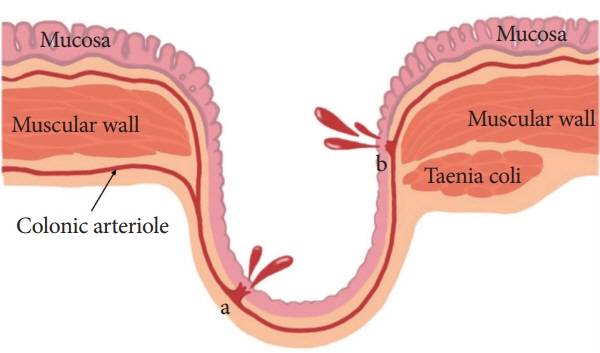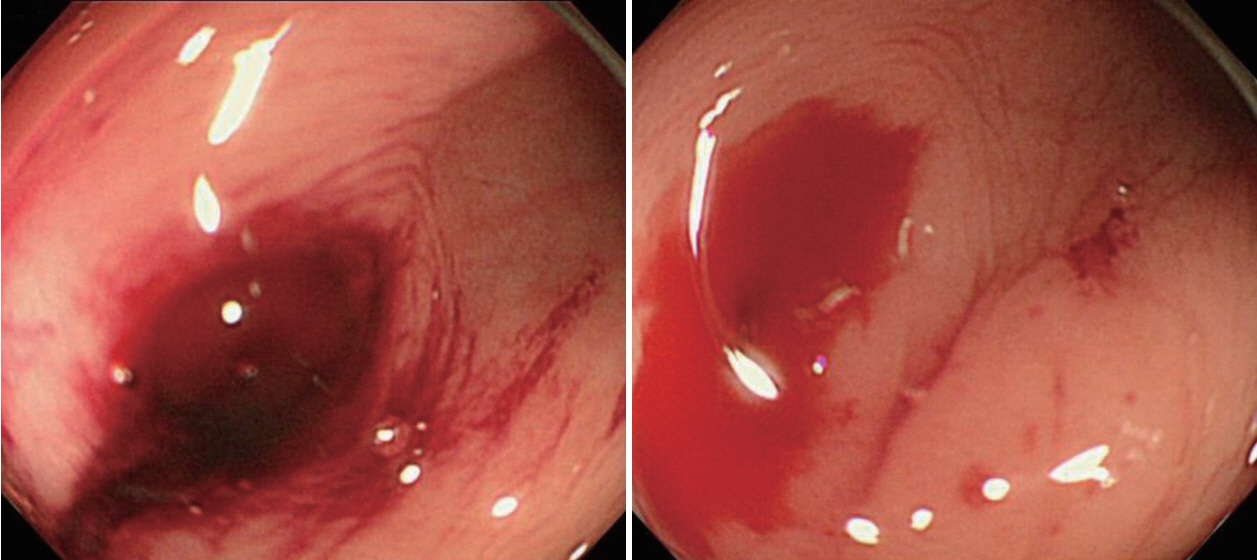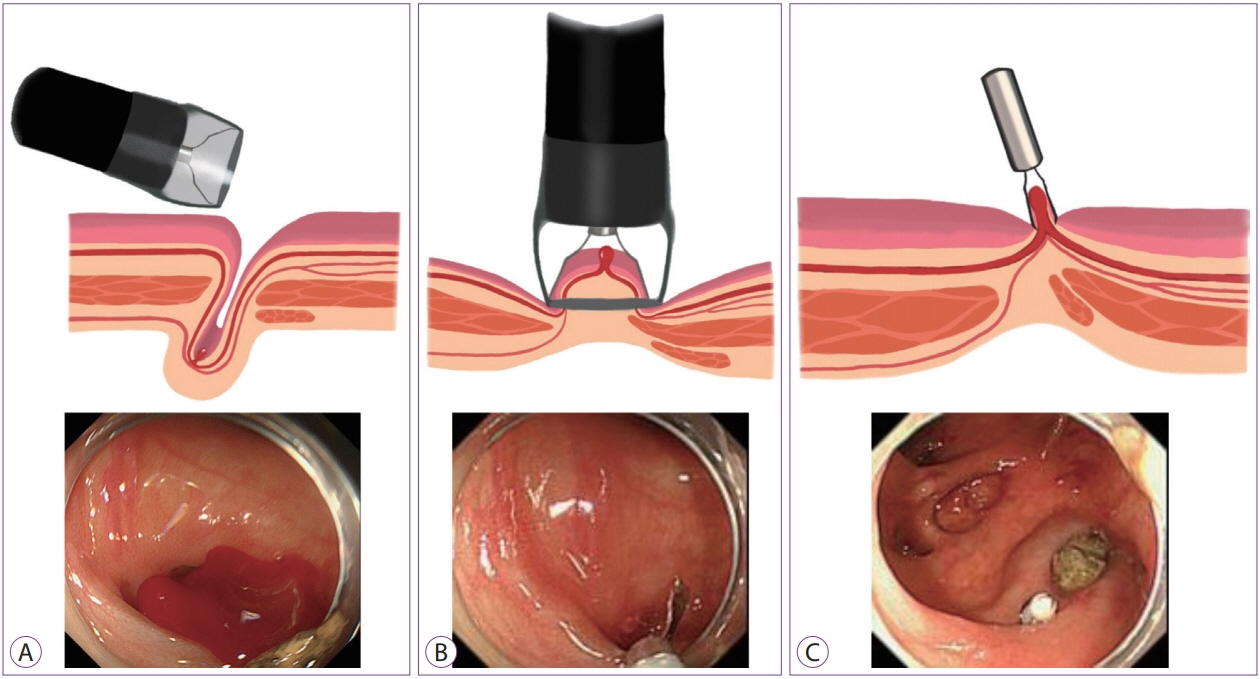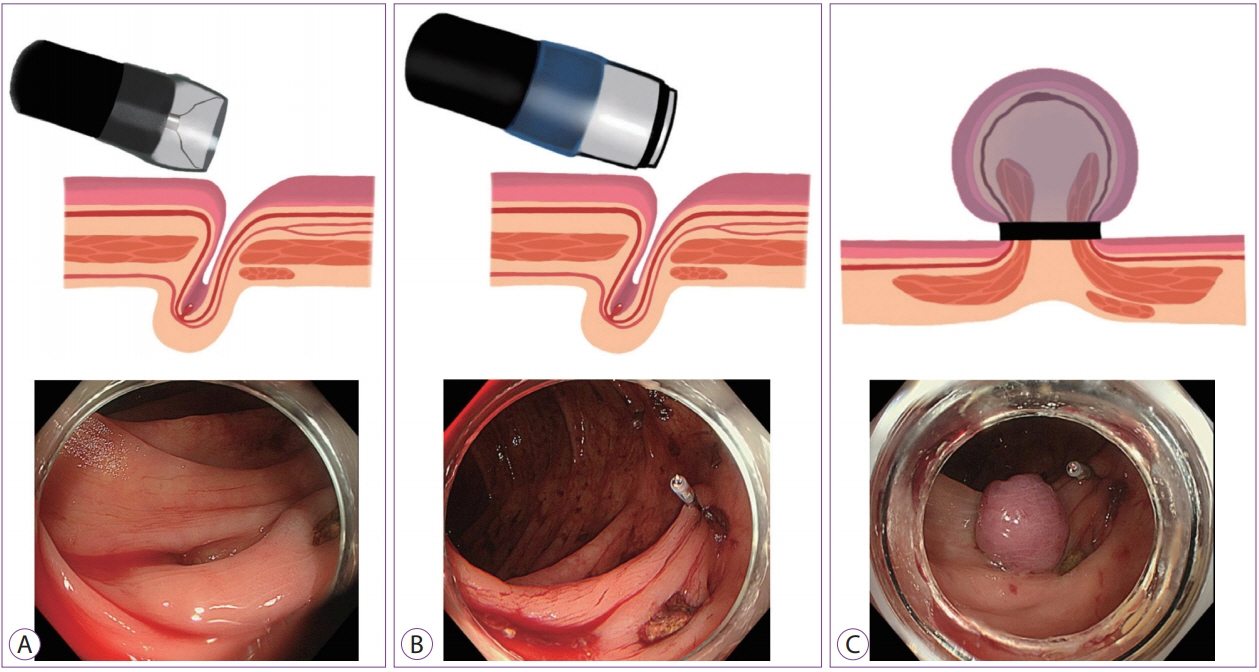Clin Endosc.
2019 Sep;52(5):419-425. 10.5946/ce.2019.078.
Endoscopic Therapy for Acute Diverticular Bleeding
- Affiliations
-
- 1Department of Endoscopy, The Jikei University Katsushika Medical Center, Tokyo, Japan. masakato89@gmail.com
- KMID: 2464662
- DOI: http://doi.org/10.5946/ce.2019.078
Abstract
- Diverticular bleeding accounts for approximately 26%-40% of the cases of lower gastrointestinal bleeding. Rupture of the vasa recta at the neck or dome of the diverticula can be the cause of this bleeding. Colonoscopy aids in not only the diagnosis but also the treatment of diverticular bleeding after a steady bowel preparation. Endoscopic hemostasis involves several methods, such as injection/thermal contact therapy, clipping, endoscopic band ligation (EBL), hemostatic powder, and over-the-scope clips. Each endoscopic method can provide a secure initial hemostasis. With regard to the clinical outcomes after an endoscopic treatment, the methods reportedly have no significant differences in the initial hemostasis and early recurring bleeding; however, EBL might prevent the need for transcatheter arterial embolization or surgery. In contrast, the long-term outcomes of the endoscopic treatments, such as a late bleeding and recurrent bleeding at 1 and 2 years, are not well known for diverticular bleeding. With regard to a cure for diverticular bleeding, there should be an improvement in both the endoscopic methods and the multilateral perspectives, such as diet, medicines, interventional approaches, and surgery.
Keyword
MeSH Terms
Figure
Cited by 1 articles
-
Diagnosis and Treatment of Colonic Diverticular Disease
You Sun Kim
Korean J Gastroenterol. 2022;79(6):233-243. doi: 10.4166/kjg.2022.072.
Reference
-
1. Oakland K, Guy R, Uberoi R, et al. Acute lower GI bleeding in the UK: patient characteristics, interventions and outcomes in the first nationwide audit. Gut. 2018; 67:654–662.
Article2. Nagata N, Niikura R, Aoki T, et al. Role of urgent contrast-enhanced multidetector computed tomography for acute lower gastrointestinal bleeding in patients undergoing early colonoscopy. J Gastroenterol. 2015; 50:1162–1172.
Article3. Ishii N, Hirata N, Omata F, et al. Location in the ascending colon is a predictor of refractory colonic diverticular hemorrhage after endoscopic clipping. Gastrointest Endosc. 2012; 76:1175–1181.
Article4. Jensen DM, Machicado GA, Jutabha R, Kovacs TO. Urgent colonoscopy for the diagnosis and treatment of severe diverticular hemorrhage. N Engl J Med. 2000; 342:78–82.
Article5. Stollman N, Raskin JB. Diverticular disease of the colon. Lancet. 2004; 363:631–639.
Article6. Meyers MA, Alonso DR, Baer JW. Pathogenesis of massively bleeding colonic diverticulosis: new observations. AJR Am J Roentgenol. 1976; 127:901–908.
Article7. Frattaroli FM, Casciani E, Spoletini D, et al. Prospective study comparing multi-detector row CT and endoscopy in acute gastrointestinal bleeding. World J Surg. 2009; 33:2209–2217.
Article8. Kaltenbach T, Watson R, Shah J, et al. Colonoscopy with clipping is useful in the diagnosis and treatment of diverticular bleeding. Clin Gastroenterol Hepatol. 2012; 10:131–137.
Article9. Strate LL, Gralnek IM. ACG clinical guideline: management of patients with acute lower gastrointestinal bleeding. Am J Gastroenterol. 2016; 111:459–474.
Article10. Strate LL, Syngal S. Predictors of utilization of early colonoscopy vs. radiography for severe lower intestinal bleeding. Gastrointest Endosc. 2005; 61:46–52.
Article11. García-Blázquez V, Vicente-Bártulos A, Olavarria-Delgado A, Plana MN, van der Winden D, Zamora J. Accuracy of CT angiography in the diagnosis of acute gastrointestinal bleeding: systematic review and meta-analysis. Eur Radiol. 2013; 23:1181–1190.
Article12. Lim DS, Kim HG, Jeon SR, et al. Comparison of clinical effectiveness of the emergent colonoscopy in patients with hematochezia according to the type of bowel preparation. J Gastroenterol Hepatol. 2013; 28:1733–1737.
Article13. Jensen DM, Ohning GV, Kovacs TO, et al. Natural history of definitive diverticular hemorrhage based on stigmata of recent hemorrhage and colonoscopic Doppler blood flow monitoring for risk stratification and definitive hemostasis. Gastrointest Endosc. 2016; 83:416–423.
Article14. Saito K, Inamori M, Sekino Y, et al. Management of acute lower intestinal bleeding: what bowel preparation should be required for urgent colonoscopy? Hepatogastroenterology. 2009; 56:1331–1334.15. Smoot RL, Gostout CJ, Rajan E, et al. Is early colonoscopy after admission for acute diverticular bleeding needed? Am J Gastroenterol. 2003; 98:1996–1999.
Article16. Shibata S, Shigeno T, Fujimori K, Kanai K, Yoshizawa K. Colonic diverticular hemorrhage: the hood method for detecting responsible diverticula and endoscopic band ligation for hemostasis. Endoscopy. 2014; 46:66–69.
Article17. Niikura R, Nagata N, Aoki T, et al. Predictors for identification of stigmata of recent hemorrhage on colonic diverticula in lower gastrointestinal bleeding. J Clin Gastroenterol. 2015; 49:e24–e30.
Article18. Bloomfeld RS, Rockey DC, Shetzline MA. Endoscopic therapy of acute diverticular hemorrhage. Am J Gastroenterol. 2001; 96:2367–2372.
Article19. Green BT, Rockey DC, Portwood G, et al. Urgent colonoscopy for evaluation and management of acute lower gastrointestinal hemorrhage: a randomized controlled trial. Am J Gastroenterol. 2005; 100:2395–2402.
Article20. Iqbal CW, Cullinane DC, Schiller HJ, Sawyer MD, Zietlow SP, Farley DR. Surgical management and outcomes of 165 colonoscopic perforations from a single institution. Arch Surg. 2008; 143:701–706. discussion 706-707.
Article21. Ishii N, Omata F, Nagata N, Kaise M. Effectiveness of endoscopic treatments for colonic diverticular bleeding. Gastrointest Endosc. 2018; 87:58–66.22. Couto-Worner I, González-Conde B, Estévez-Prieto E, Alonso-Aguirre P. Colonic diverticular bleeding: urgent colonoscopy without purging and endoscopic treatment with epinephrine and hemoclips. Rev Esp Enferm Dig. 2013; 105:495–498.
Article23. Yen EF, Ladabaum U, Muthusamy VR, Cello JP, McQuaid KR, Shah JN. Colonoscopic treatment of acute diverticular hemorrhage using endoclips. Dig Dis Sci. 2008; 53:2480–2485.
Article24. Kume K, Yamasaki M, Yoshikawa I. Sepsis caused by endoscopic clipping for colonic diverticular bleeding: a rare complication. World J Gastroenterol. 2009; 15:3817–3818.
Article25. Ishii N, Setoyama T, Deshpande GA, et al. Endoscopic band ligation for colonic diverticular hemorrhage. Gastrointest Endosc. 2012; 75:382–387.
Article26. Nakano K, Ishii N, Ikeya T, et al. Comparison of long-term outcomes between endoscopic band ligation and endoscopic clipping for colonic diverticular hemorrhage. Endosc Int Open. 2015; 3:E529–E533.
Article27. Takahashi S, Inaba T, Tanaka N. Delayed perforation after endoscopic band ligation for treatment of colonic diverticular bleeding. Dig Endosc. 2016; 28:484.
Article28. Sundaram CP, Keenan AC. Evolution of hemostatic agents in surgical practice. Indian J Urol. 2010; 26:374–378.
Article29. Goker H, Haznedaroglu IC, Ercetin S, et al. Haemostatic actions of the folkloric medicinal plant extract Ankaferd blood stopper. J Int Med Res. 2008; 36:163–170.
Article30. ASGE Technology Committee, Wong Kee Song LM, Banerjee S, et al. Emerging technologies for endoscopic hemostasis. Gastrointest Endosc. 2012; 75:933–937.
Article31. Giday SA, Kim Y, Krishnamurty DM, et al. Long-term randomized controlled trial of a novel nanopowder hemostatic agent (TC-325) for control of severe arterial upper gastrointestinal bleeding in a porcine model. Endoscopy. 2011; 43:296–299.
Article32. Sung JJ, Luo D, Wu JC, et al. Early clinical experience of the safety and effectiveness of Hemospray in achieving hemostasis in patients with acute peptic ulcer bleeding. Endoscopy. 2011; 43:291–295.
Article33. Smith LA, Stanley AJ, Bergman JJ, et al. Hemospray application in nonvariceal upper gastrointestinal bleeding: results of the survey to evaluate the application of Hemospray in the luminal tract. J Clin Gastroenterol. 2014; 48:e89–e92.34. Chen YI, Barkun AN, Soulellis C, Mayrand S, Ghali P. Use of the endoscopically applied hemostatic powder TC-325 in cancer-related upper GI hemorrhage: preliminary experience (with video). Gastrointest Endosc. 2012; 75:1278–1281.
Article35. Holster IL, Kuipers EJ, Tjwa ET. Hemospray in the treatment of upper gastrointestinal hemorrhage in patients on antithrombotic therapy. Endoscopy. 2013; 45:63–66.
Article36. Holster IL, Brullet E, Kuipers EJ, Campo R, Fernández-Atutxa A, Tjwa ET. Hemospray treatment is effective for lower gastrointestinal bleeding. Endoscopy. 2014; 46:75–78.
Article37. Aslan E, Akyüz Ü, Pata C. The use of Ankaferd in diverticular bleeding: two case reports. Turk J Gastroenterol. 2013; 24:441–443.
Article38. Chen YI, Barkun AN. Hemostatic powders in gastrointestinal bleeding: a systematic review. Gastrointest Endosc Clin N Am. 2015; 25:535–552.39. Mourad FH, Leong RW. Role of hemostatic powders in the management of lower gastrointestinal bleeding: a review. J Gastroenterol Hepatol. 2018; 33:1445–1453.
Article40. Matthes K, Jung Y, Kato M, Gromski MA, Chuttani R. Efficacy of full-thickness GI perforation closure with a novel over-the-scope clip application device: an animal study. Gastrointest Endosc. 2011; 74:1369–1375.
Article41. Weiland T, Fehlker M, Gottwald T, Schurr MO. Performance of the OTSC system in the endoscopic closure of iatrogenic gastrointestinal perforations: a systematic review. Surg Endosc. 2013; 27:2258–2274.
Article42. Shoar S, Poliakin L, Khorgami Z, et al. Efficacy and safety of the over-the-sope clip (OTSC) system in the management of leak and fistula after laparoscopic sleeve gastrectomy: a systematic review. Obes Surg. 2017; 27:2410–2418.43. Wedi E, von Renteln D, Jung C, et al. Treatment of acute colonic diverticular bleeding in high risk patients, using an over-the-scope clip: a case series. Endoscopy. 2016; 48:E383–E385.
Article44. Longstreth GF. Epidemiology and outcome of patients hospitalized with acute lower gastrointestinal hemorrhage: a population-based study. Am J Gastroenterol. 1997; 92:419–424.45. Tanaka Y, Motomura Y, Akahoshi K, et al. Predictive factors for colonic diverticular rebleeding: a retrospective analysis of the clinical and colonoscopic features of 111 patients. Gut Liver. 2012; 6:334–338.
Article46. Aytac E, Stocchi L, Gorgun E, Ozuner G. Risk of recurrence and longterm outcomes after colonic diverticular bleeding. Int J Colorectal Dis. 2014; 29:373–378.
Article47. Niikura R, Nagata N, Yamada A, Akiyama J, Shimbo T, Uemura N. Recurrence of colonic diverticular bleeding and associated risk factors. Colorectal Dis. 2012; 14:302–305.
Article48. Nishikawa H, Maruo T, Tsumura T, Sekikawa A, Kanesaka T, Osaki Y. Risk factors associated with recurrent hemorrhage after the initial improvement of colonic diverticular bleeding. Acta Gastroenterol Belg. 2013; 76:20–24.49. Okamoto T, Watabe H, Yamada A, Hirata Y, Yoshida H, Koike K. The association between arteriosclerosis related diseases and diverticular bleeding. Int J Colorectal Dis. 2012; 27:1161–1166.
Article
- Full Text Links
- Actions
-
Cited
- CITED
-
- Close
- Share
- Similar articles
-
- The usefulness of endoscopic hemostasis with hemoclipping in acute colonic diverticular bleeding
- Successful Management of Periampullary Diverticular Bleeding with Hemoclipping Using Side-viewing Endoscope during Endoscopic Retrograde Cholangiopancreatography
- A Case of Colonic Diverticular Bleeding Treated with Endoscopic Hemoclip
- 4 Cases of Duodenal Diverticular Bleeding Treated by Endoscopic Therapy
- Recent updates on classification and unsolved issues of diverticular disease: a narrative review







